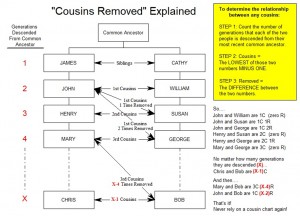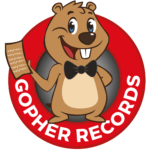People ask me all the time what a “Third Cousin Twice Removed” (aka 3C2R) is, for instance. The internet is full of “cousin charts” but I really don’t understand the point of them and I discourage their use. The rules to navigate the chart are more complicated than the rules to just calculate the relationship yourself! (And Step 1 is the same for both).
Spend 5 minutes to understand this chart that I made for a friend and you’ll never have to rely on this or any other chart again.
And, by the way, cousin relationships are reciprocal. On my chart, for instance, John’s relationship to George is the same as George’s relationship to John (1C2R). So don’t worry about whether your line goes on the left or right side. And no, it doesn’t matter whether the two lines of ascent go through male ancestors, female ancestors, or both, to get to the common ancestor. That doesn’t affect the cousin relationship. Finally, the two people only need to be descended from ONE common ancestor* and it doesn’t matter whether it is a male or female.
Now, it’s true that, unlike those “other” charts, mine doesn’t explain what a great-great-grandfather is. And, among other things, it doesn’t explain what an uncle and a nephew is. But:
- What adult doesn’t know this already?? Besides, you have to understand what a great-great-grandfather is already in order to use those other charts!
- Unlike cousins, those other relationships are gender specific and not reciprocal. (i.e., uncle/aunt vs nephew/niece and g-g-grandfather/mother vs g-g-grandson/daughter). And there doesn’t seem to be any consensus on whether it is GREAT-uncle or GRAND-uncle, for instance.
- Is it really worth making it soooo much harder to learn what a 1C2R is by having the chart get bogged down defining terms that most people already know?
Finally, if you know what a great-grandFATHER is and you know what an uncle is, then you should know what a great-grandUNCLE is. If you don’t, then I can’t help you.
(Sorry, it’s 4am and I’m getting punchy…)
* Full disclosure: there are claims in some circles that a “cousin” requires a PAIR of common ancestors and that if there is only one, then they are “half-cousins.” It is a tedious debate so I will merely quote the Oxford English Dictionary, the universally-accepted authority on the English language, and readers can judge for themselves:
“Cousin: (1) a collateral relative more distant than a brother or sister, (2) The son or daughter of one’s uncle or aunt, (3) first, second cousin, etc.; expressing the relationship between persons descended the same number of steps in distinct lines from A COMMON ANCESTOR.” (emphasis added)


